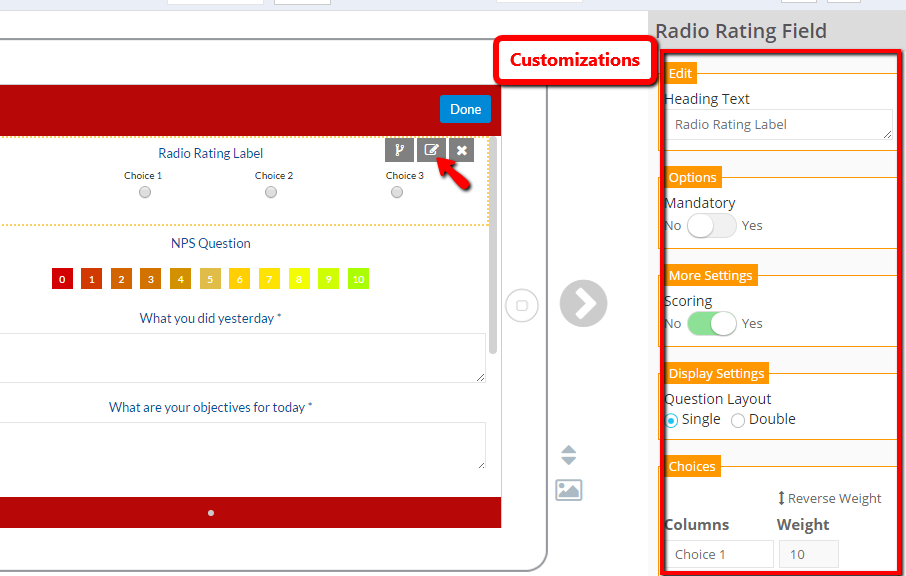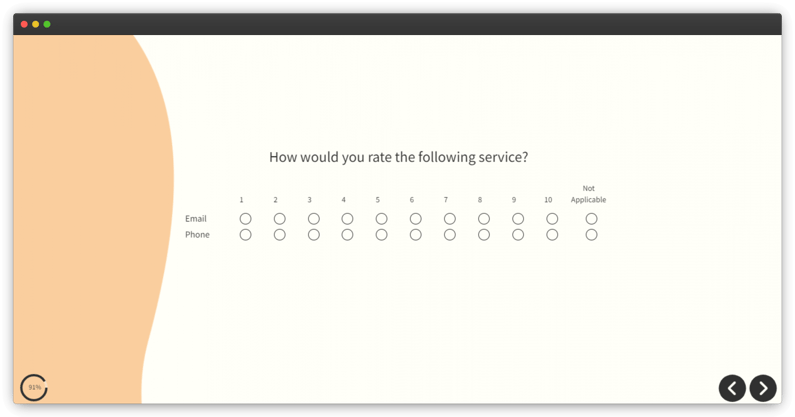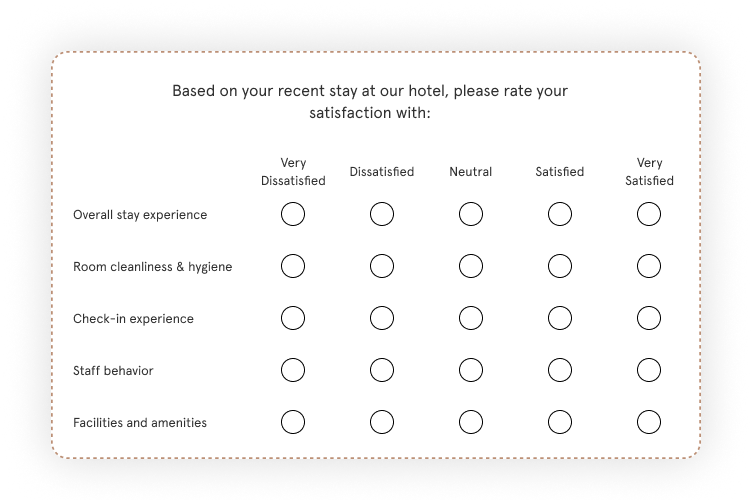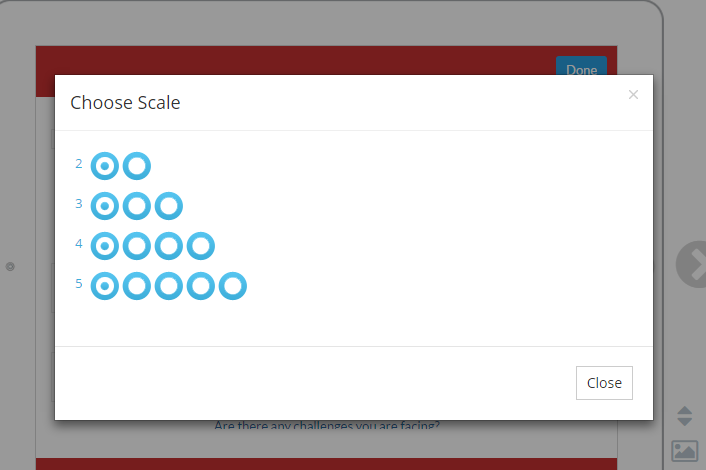Since most organizations around the globe have realized the power of customer feedback to boost their business growth, they use various types of surveys to capture feedback from their customers. Among the different survey types, matrix surveys have emerged as a powerful way to gather customer feedback about various aspects of the products, services, and overall business in a simple and quick manner.
Matrix surveys offer a structured approach, allowing respondents to share their views on a range of related topics in a cohesive format. These survey questions help you simplify your surveys and let the customers share their valuable feedback quickly and with ease.
In this article, we will explore what matrix survey questions are, their types, when to use them, how to calculate matrix survey results, some matrix survey questions and examples, and some useful tips for conducting effective matrix surveys. Let’s get started!
TL;DR
-
There are various types of surveys in place to collect customer feedback like Likert scale surveys, Thumbs up-down surveys, smiley face surveys, rating scale surveys, and more. One of those effective surveys is a matrix question survey.
-
A matrix question survey is a survey question format that organizes related sub-questions in a grid, where respondents provide feedback or ratings for multiple items within a common theme or topic. They are a powerful way for organizations seeking detailed customer feedback on various aspects of products, services, and overall business.
-
Various types of matrix surveys include Single Response, Multiple Response, Dropdown, Multiple Matrices, Likert Scale, Ranking, and Checkbox Matrices, each catering to specific survey goals.
-
Matrix questions differ from Likert scales, with matrices organizing feedback in a grid structure for efficiency, while Likert scales gauge opinions on individual statements independently.
-
Matrix survey questions are suitable for detailed feedback in scenarios like product launches, organizational assessments, and various types of surveys such as customer satisfaction, employee feedback, and more.
-
To create effective matrix surveys, you should follow some best practices - define the theme clearly, create concise questions, use clear language, maintain consistency in question types, provide clear instructions for the respondents, and ensure that surveys are optimized for mobile devices.
-
Zonka Feedback helps you create powerful matrix surveys easily to collect valuable customer feedback. It also provides a free trial for 14 days.
What is a Matrix Question?
A matrix question is a survey question format that organizes related sub-questions in a grid, where respondents provide feedback or ratings for multiple items within a common theme or topic.
They streamline the survey-taking process by grouping related questions together, reducing redundancy, and presenting a cohesive structure for respondents to navigate. These questions often utilize a Likert scale or another rating system, allowing respondents to expressParticipants can select multiple options within each row or column of the matrix. their level of agreement, satisfaction, or preference for each item in the matrix.
Matrix questions are commonly used in various types of surveys, including customer satisfaction surveys, employee feedback surveys, and academic research, to gather detailed insights on specific aspects of a subject in a systematic and organized manner.
Types of Matrix Survey Questions
Matrix survey questions are of various types.
-
Single Response Matrix - In this type of matrix, the respondents are required to choose only one of the answer choices from each row or column in the matrix. This type is ideal when each item in the matrix is mutually exclusive, and respondents must make a distinct choice for each.

-
Multiple Response Matrix - In the multiple selection matrix questions, participants can select multiple response options within each row or column of the matrix. This type is suitable when there can be more than one answer for each item in the matrix.
-
Dropdown Matrix - This is similar to single response matrix, but respondents select their answer choices from a dropdown menu. This type is useful when there are numerous options in the matrix, and a dropdown menu streamlines the presentation.
-
Multiple Matrices - This question type involves presenting multiple matrix questions in succession, each focusing on a different aspect of the survey. This is ideal when you want to capture feedback about different aspects related to various dimensions.
-
Likert Scale Matrix - Likert scale survey question matrix utilizes a Likert scale for respondents to express their level of agreement, satisfaction, or preference for each item in the matrix. It is commonly employed when assessing attitudes, opinions, or perceptions across multiple dimensions.
-
Ranking Matrix - Ranking matrix requires respondents to rank items within each row or column based on their preference, importance, or another criterion. It is useful when you want your customers to rank various aspects on the basis of performance, preference, or importance.

-
Checkbox Matrix - It is similar to a multiple response matrix, but presented in a checkbox format for respondents to select multiple answer choices within each row or column. This type is effective when respondents may have overlapping preferences or when multiple options can apply to each item.
You can choose among these types of matrix questions as per your survey needs.
How Matrix Question differ from a Likert Scale?
Matrix questions and Likert scales, while both integral to survey design, diverge in structure and application.
Matrix questions present a grid or table where respondents offer feedback or ratings for multiple related items, organized by rows and columns. This format streamlines data collection on various facets of a single theme. In contrast, Likert scales feature a series of independent statements assessed on a predefined scale, commonly measuring attitudes or opinions. Respondents select a level of agreement or disagreement without the grid structure found in matrix questions.
Matrix surveys are apt for capturing nuanced feedback on multiple dimensions, enhancing survey efficiency, while Likert scales excel in straightforwardly gauging opinions on individual statements, simplifying the respondent experience. 
While both matrix questions and Likert scales serve the purpose of measuring respondent opinions, they differ in their structural organization and focus. Matrix questions are well-suited for gathering comprehensive feedback on multiple aspects of a topic, while Likert scales are effective for assessing opinions on individual statements straightforwardly.
When to use Matrix Survey Questions?
Matrix survey questions are particularly useful in certain situations where you want to gather detailed feedback on multiple aspects of a single theme or topic. For instance, you have launched a new product and you want to collect detailed feedback about each aspect of the product. In such a case, you can ask your customers to rate the product and provide feedback about various product features and on different parameters like speed, accuracy, quality, and more.
Similarly, if you want to gather feedback about a particular organization from your customers or employees, matrix surveys can help you obtain feedback separately about various aspects of your organization.
This makes matrix survey questions suitable for various types of surveys:
-
Customer satisfaction surveys - Use matrix survey questions to gather detailed feedback on various aspects of your products or services, enhancing customer satisfaction insights.
-
Patient satisfaction surveys - Employ matrix surveys to collect nuanced feedback from patients, addressing different dimensions of their healthcare experience, from service quality to facility amenities.
-
Employee feedback surveys - Leverage matrix questions to obtain comprehensive feedback from employees on diverse aspects of the workplace, including leadership, work environment, and career development.
-
Student feedback surveys - Opt for matrix survey questions to explore multiple facets of the student experience, from course content to teaching methodologies and campus facilities.
-
Hotel guest feedback surveys - Enhance hotel guest feedback surveys with matrix questions to evaluate and improve various aspects of the guest experience, such as room quality, amenities, and customer service.
-
Restaurant feedback surveys - Utilize matrix surveys to capture detailed insights on different elements of the dining experience, including food quality, service, ambience, and overall satisfaction.
-
Product feedback surveys - Choose matrix survey questions when launching a new product to collect comprehensive feedback on various product features, ensuring a well-rounded understanding of customer preferences.
Let’s explore some examples of matrix survey questions.
Matrix Survey Question Examples
Here are some matrix survey question examples across different survey types:
1. Customer Satisfaction Survey
Please rate your satisfaction with the following aspects of our service:
Product Quality
Timeliness of Delivery
Customer Support
Website User Interface
2. Employee Feedback Survey
Indicate your agreement with the following statements regarding the work environment:
The organization values employee input.
Opportunities for professional development are provided.
Communication from leadership is clear and transparent.
Team collaboration is encouraged.
3. Product Feedback Survey
Rate the following features of our new product on a scale from 1 to 5:
Ease of Use
Design Aesthetics
Functionality
Value for Money
4. Hotel Guest Feedback Survey
Please provide feedback on the following aspects of your stay:
Room Cleanliness
Check-in and Check-out Process
Staff Friendliness
Amenities Offered
5. Restaurant Feedback Survey
Indicate your satisfaction with the following aspects of your dining experience:
Food Quality
Service Speed
Ambiance
Value for Price
6. Patient Satisfaction Survey
Please rate your satisfaction with the following aspects of your healthcare experience:
Quality of Care
Communication with Healthcare Providers
Waiting Time
Availability of Information
7. Student Feedback Survey
Rate your experience in the following areas:
Clarity of Course Content
Effectiveness of Teaching Methods
Availability of Learning Resources
Overall Learning Experience
Calculating Matrix Survey Results
Creating matrix surveys is one thing, but to utilize them and the feedback data collected through them, you need to analyze the survey results and calculate a quantitative figure for matrix survey results.
These surveys allow your customers to evaluate and rate multiple aspects of your products, services, and the overall business using column choices. Use a good tool like Zonka Feedback which provides you with powerful reporting and analytics features. This will help you know how many times your customers selected particular response options.
With the help of this data, you will be able to identify which row got how many responses in percentage. To calculate this, you need to divide the number of responses with a particular answer choice by the total number of responses and multiply it by 100 to get the exact percentage. Here is the formula for this:
Number of Responses for the Response Option/ Number of Total Responses x 100
Let’s learn some best practices for writing matrix questions.
Tips on Writing Effective Matrix Questions
Writing effective matrix questions is crucial for obtaining accurate and insightful survey responses. Here are some tips to help you craft matrix questions that enhance respondent understanding and provide meaningful information with good feedback data quality.
-
Clearly define the theme - Ensure that the matrix question revolves around a clear and specific theme or topic. This clarity helps respondents understand the context and provide relevant feedback.
-
Keep it concise - Avoid overwhelming respondents with lengthy matrices. Avoid too many rows and keep the number of rows and columns manageable to maintain respondent engagement and reduce survey fatigue.
-
Use clear and simple language - Write clear and concise statements or instructions for each matrix item. Use language that is easily understandable to your target audience to minimize confusion.
-
Maintain Consistency - Ensure consistency in the response format throughout the matrix. Whether you're using Likert scales, dropdowns, or checkboxes, maintain uniformity to simplify the respondent experience.
-
Avoid double-barrelled questions - Each matrix item should address a single concept or dimension. Avoid combining multiple ideas in one item, as this can lead to ambiguous responses.
-
Provide clear instructions - Clearly instruct respondents on how to approach the matrix. For example, specify whether they should choose one option per row or column, or if multiple selections are allowed.
-
Ensure mobile responsiveness - If your survey will be accessed on mobile devices, ensure that the matrix format is user-friendly and displays well on smaller screens. Test the survey on various devices to confirm responsiveness.
Let’s learn how you can create engaging matrix surveys with Zonka Feedback
Create Engaging Surveys with Matrix Questions with Zonka Feedback
Zonka Feedback enables you to easily create engaging matrix question surveys for collecting feedback from your customers. You need to follow these simple steps for this purpose:
-
Create an account in Zonka Feedback and sign up for a free trial.
-
Use Zonka Feedback survey templates to create the survey type of your choice.
-
Go to the survey to add a matrix questions to it.
-
Choose Rating and Scales from the questions box on the left side.
-
Form the Rating and Scales list that appears on the screen, choose Matrix rating and the matrix question will be added to your survey and will appear in the preview on your screen.
-
Click on it and you will get options to select the rating scale. Select the rating scale from there from a 2 to 5-point rating scale.

-
Then you can customize the question as per your survey requirements.
Conclusion
Matrix scale surveys are a great way to collect customer feedback about various aspects of your products, services, and business in a quick and easy way. These surveys offer a structured approach, enabling respondents to share views on diverse topics cohesively and succinctly. Whether launching a new product, assessing organizational performance, or enhancing customer satisfaction, matrix surveys streamline the data quality collection process.
To create effective surveys, you should use an effective customer feedback tool. Zonka Feedback is one such software that you can use for this purpose. The tool not only helps you craft powerful matrix questions and create effective surveys but also helps you send them through multiple channels and take instant actions on feedback to close the feedback loop and improve customer experience.
It also offers a free trial. Try Zonka Feedback for free for 14 days and harness the power of matrix surveys to improve and grow your business.

 MS Teams
MS Teams












